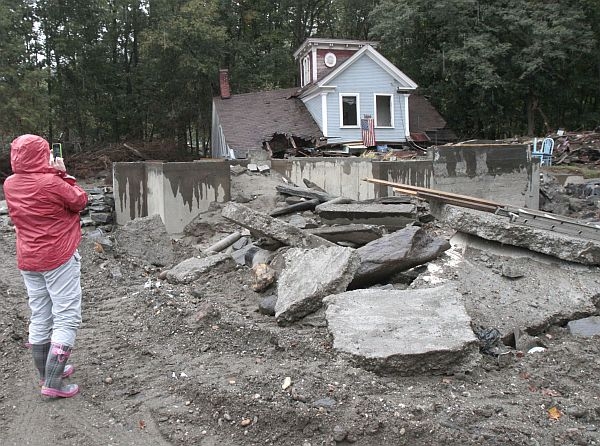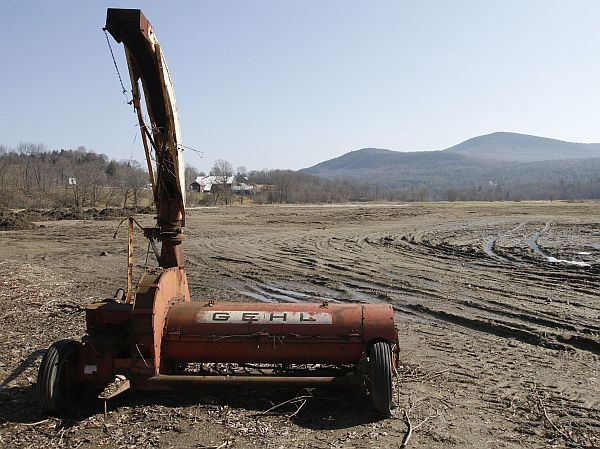
Over the past year we’ve heard lots of numbers in relation to Tropical Storm Irene, but it’s a challenge to come up with a grand total for the damage done by the storm.
Nicholas Clifford co-wrote a book on Vermont’s historic 1927 flood. It’s called The Troubled Roar Of The Waters. These days when Clifford gives talks about that flood, his audiences often ask him to compare it to Irene.
"They want to know how much 1927 costs, which I can only guess. And they want to know how much Irene costs," Clifford explains
In response to questions about the total cost of Irene damage, Clifford has a three word answer: "I don’t know!"
There’s no shortage of figures to help us measure the storm’s impact. Among those Irene Recovery Officer Sue Minter recitesat her public presentations:
· 50,000 people lost power
· 3,500 homes damaged or destroyed
· 629 historic and cultural sites damaged
· 20,000 acres of farmland flooded
 But arriving at a dollar figure for how much damage Irene caused isn’t so easy. The closest anyone has come is a figure included in the June Irene Recovery Status Report.
But arriving at a dollar figure for how much damage Irene caused isn’t so easy. The closest anyone has come is a figure included in the June Irene Recovery Status Report.
"We actually pulled together a table of all the known resources that we could put our hands around," Minter says. "Primarily it’s federal, state and local funds, as well as private donations, what we could learn about insurance. And we learned that $733 million of funds that we knew about that were some of the costs of Irene. But we don’t see that as the total cost."
Minter says there are a couple of reasons why the $733 million doesn’t reflect a total damage estimate.
First, while it includes the major sources of funding for Irene recovery, lots of money came from many other places.
"We haven’t aggregated what it’s cost towns to do that cleanup," she says. "The same with farms and individual property owners. Business costs, that’s such a big one."
Also, even if we could gather all the figures together, we’d only get a sense of what we’ve spent on recovery, not how much damage there actually was.
The best documented and biggest share of Irene damage is that done to public property.
Employees of the Vermont Agency of Transportation have logged over 236,000 hours on Irene recovery work. That’s largely covered by the federal government, as part of the cost of repairs to roads, bridges, rail lines.
Add in river and stream work and the damage done at the Waterbury Office Complex and all told, repairs to public property come in in the neighborhood of $570 million dollars.
Another major category of Irene related costs is damage to personal property.
We know the amount of damage to personal property covered by FEMA assistance, flood insurance and SBA loans to individuals. And we can estimate the help they received from local recovery funds. That’s about $130 million.
But we don’t know what people paid from their own pockets or borrowed from banks.
On top of the individual losses that have been paid for, it’s believed that millions more are needed to help people fully recover from Irene.
The business losses from Irene are the most difficult costs to pin down.
Kevin Downey lost his downtown Wilmington café to the flood. Insurance covered just 30 percent. He and his wife Lori absorbed the rest and eventually decided not to reopen their business.
Other businesses hit by the flood have reopened. On top of SBA and Vermont Development Authority Loans some owners took out bank loans, or they used savings or retirement money to help rebuild. We’ll never know those numbers.
Pat Moulton Powden is Deputy Secretary of the Vermont Agency of Commerce and Community Development. She says any figure representing businesses losses is at best a very rough estimate.
"It’s really hard to put a good bead on the total number," Moulton Powden explains. "We expect the total impact exceeds $80 million just from the business impact, and that may be a conservative estimate."
The $80 million doesn’t include some big figures, like the recovery costs to Vermont utilities and to Fairpoint Communications. Those alone total more than $16 million.
Finally farm losses can only be estimated based on applications for aid and money spent on farm stream bank stabilization. It’s thought that much of the damage to farms has not been paid for.
So, using the Irene Recovery Office numbers and adding the others we’ve collected, we come up with well over $800 million in estimated storm damage.
But that figure and any others will always need an asterisk beside them for all the costs we can’t calculate and the fact that many of the numbers we have are rough estimates.
For historian and author Nicholas Clifford a total damage figure is useful for comparison’s sake, but it’s not the most important thing we take from the Irene experience.
"It’s not the real story, after all. The real story is the recovery and how people put things back together," says Clifford.
In the end Clifford’s three word answer to the question of how much damage Irene did may be the best: We don’t know.